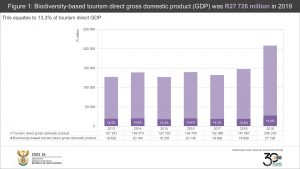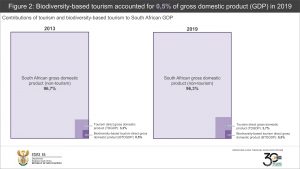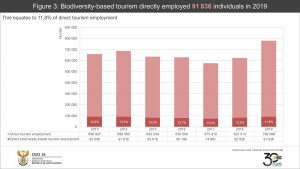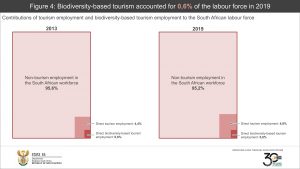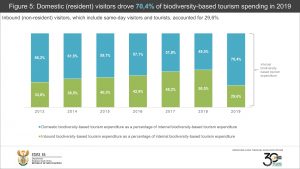The role of biodiversity-based tourism in South Africa
A first of its kind, the release of South Africa’s experimental estimates for biodiversity-based tourism paints a picture of this sector’s contribution to economic activity, employment and tourism spend.
What is biodiversity-based tourism? If you visit a game park, hike at a nature reserve, snorkel along the coast, relax in a national botanical garden, or enjoy any of South Africa’s biodiversity assets for recreation, you’re engaging in biodiversity-based tourism. The sector includes tourism activities linked to South Africa’s natural ecosystems and/or indigenous species.
Measuring biodiversity-based tourism requires an understanding of the economic value of the sector. This is made up of two elements. First, the price that both domestic (resident) and inbound (non-resident) visitors pay for tourism products and services that are based on the enjoyment of biodiversity assets and ecosystem services. Second, the direct spending on other related tourism businesses (such as food and beverages, passenger transportation, accommodation, etc.) that supply supporting goods and services.
The Experimental Biodiversity-Based Tourism Estimates for South Africa, 2013 to 2019 discussion document provides insight into the economic value of biodiversity-based tourism and its significance to South Africa’s tourism sector as a whole.
Below are key takeaways from the report.
- Contribution to the tourism sector and national GDP
Biodiversity-based tourism forms part of the broader tourism sector, as shown in Figure 1. In 2019, biodiversity-based tourism’s direct gross domestic product (GDP) was R27 726 million (or R27,7 billion), driving 13,3% of economic activity within the broader tourism sector. In other words, for every R100 generated by the tourism sector, R13,30 was from biodiversity-based tourism.
The contribution of biodiversity-based tourism to tourism direct GDP was highest in 2013 (15,4%), declining to a low of 12,8% in 2018 before rising to 13,3% in 2019.
In terms of national GDP, biodiversity-based tourism contributed 0,5% to South Africa’s economy in 2019 (Figure 2).
The tourism sector as a whole accounted for 3,7% of the GDP, slightly up from 3,3% in 2013. This specific metric is from Stats SA’s Tourism satellite account for South Africa (TSA) report1, which provides an overview of the role that the broader tourism sector plays in the economy. Using the TSA for South Africa as a base, Stats SA used data from the South African Tourism (SAT) Departure Survey and its own Domestic Tourism Survey to compile the estimates in the biodiversity-based tourism discussion document.
- Contribution to tourism employment and the South African workforce
Biodiversity-based tourism accounted for 11,8% of jobs in the tourism sector in 2019 (Figure 3). In the period 2013–2019, the contribution of biodiversity-based tourism to overall tourism employment was the highest in 2013, declining to a low in 2019.
The rise in direct biodiversity-based tourism employment between 2018 and 2019 is in line with the sharp increase in overall direct tourism employment.
According to the TSA, the broader tourism sector employs more people than the mining and utility industries. If we consider the entire South African employed workforce, 4,8% work in tourism, and 0,6% rely on biodiversity-based tourism for their livelihoods (Figure 4).
- Expenditure
Tourism expenditure represents money spent by domestic (resident) visitors and inbound (non-resident) visitors during their travels. Visitors typically buy various tourism products and services, such as accommodation, recreation, passenger transportation and food. This money is a critical source of tourism revenue, supporting activity and growth within the sector.
Figure 5 illustrates how domestic visitors are the lifeblood of biodiversity-based tourism. In 2019, domestic visitors were responsible for 70,4% of total biodiversity-based tourism expenditure. Inbound visitors, which include same-day visitors and tourists from other countries, contributed 29,6%.
Except for 2018, domestic visitors were responsible for most of the biodiversity-based tourism expenditure in the 2013–2019 period. The most popular biodiversity-based activities by domestic visitors included trips to the beach, wildlife activities, trips to parks and gardens, and visits to mountainous areas.
For more information, download the Experimental Biodiversity-Based Tourism Estimates for South Africa, 2013 to 2019 discussion document here.
This is the fifth discussion document published by Stats SA in the Natural Capital Accounting (NCA) series. Stats SA compiled the experimental biodiversity-based tourism estimates with collaboration from the National Department of Tourism, the Department of Forestry, Fisheries and the Environment (DFFE), South African Tourism (SAT) and the South African National Biodiversity Institute (SANBI). These accounts contribute to the implementation of the National NCA Strategy.
The other four discussion documents available in the NCA series include:
- Land and Terrestrial Ecosystem Accounts, 1990 to 2014 (download here).
- Accounts for Protected Areas, 1900 to 2020 (download here).
- Accounts for Strategic Water Source Areas, 1990 to 2020 (download here).
- Sub-national Water Resource Accounts, 2015 to 2021 (download here).
1 Stats SA, Tourism Satellite Account for South Africa (download here).
Similar articles are available on the Stats SA website and can be accessed here.


